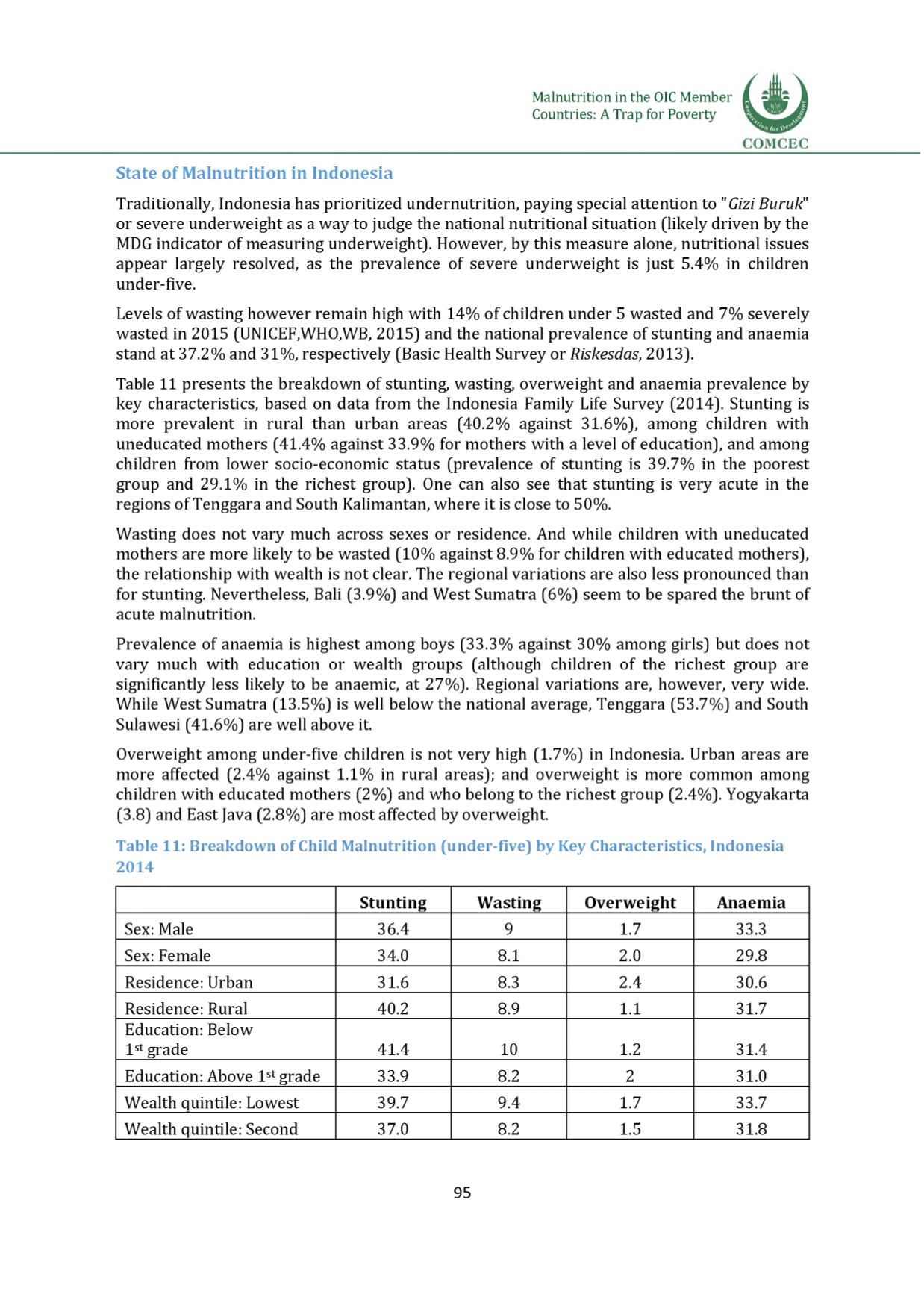

Malnutrition in the OIC Member
Countries: A Trap for Poverty
State of Malnutrition in Indonesia
Traditionally, Indonesia has prioritized undernutrition, paying special attention to
"Gizi Buruk"
or severe underweight as a way to judge the national nutritional situation (likely driven by the
MDG indicator of measuring underweight]. However, by this measure alone, nutritional issues
appear largely resolved, as the prevalence of severe underweight is just 5.4% in children
under-five.
Levels of wasting however remain high with 14% of children under 5 wasted and 7% severely
wasted in 2015 (UNICEF,WHO,WB, 2015] and the national prevalence of stunting and anaemia
stand at 37.2% and 31%, respectively (Basic Health Survey or
Riskesdas,
2013].
Table 11 presents the breakdown of stunting, wasting, overweight and anaemia prevalence by
key characteristics, based on data from the Indonesia Family Life Survey (2014). Stunting is
more prevalent in rural than urban areas (40.2% against 31.6%], among children with
uneducated mothers (41.4% against 33.9% for mothers with a level of education], and among
children from lower socio-economic status (prevalence of stunting is 39.7% in the poorest
group and 29.1% in the richest group]. One can also see that stunting is very acute in the
regions of Tenggara and South Kalimantan, where it is close to 50%.
Wasting does not vary much across sexes or residence. And while children with uneducated
mothers are more likely to be wasted (10% against 8.9% for children with educated mothers],
the relationship with wealth is not clear. The regional variations are also less pronounced than
for stunting. Nevertheless, Bali (3.9%] and West Sumatra (
6
%] seem to be spared the brunt of
acute malnutrition.
Prevalence of anaemia is highest among boys (33.3% against 30% among girls] but does not
vary much with education or wealth groups (although children of the richest group are
significantly less likely to be anaemic, at 27%]. Regional variations are, however, very wide.
While West Sumatra (13.5%] is well below the national average, Tenggara (53.7%] and South
Sulawesi (41.6%] are well above it.
Overweight among under-five children is not very high (1.7%] in Indonesia. Urban areas are
more affected (2.4% against 1.1% in rural areas]; and overweight is more common among
children with educated mothers (2%] and who belong to the richest group (2.4%]. Yogyakarta
(3.8] and East Java (2.8%] are most affected by overweight.
Table 11: Breakdown of ChildMalnutrition (under-five) by Key Characteristics, Indonesia
2014
Stunting
Wasting Overweight
Anaemia
Sex: Male
36.4
9
1.7
33.3
Sex: Female
34.0
8. 1
2. 0
29.8
Residence: Urban
31.6
8.3
2.4
30.6
Residence: Rural
40.2
8.9
1.1
31.7
Education: Below
1
st grade
41.4
10
1.2
31.4
Education: Above 1st grade
33.9
8. 2
2
31.0
Wealth quintile: Lowest
39.7
9.4
1.7
33.7
Wealth quintile: Second
37.0
8. 2
1.5
31.8
95
















